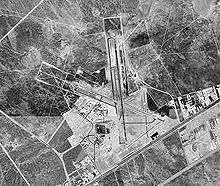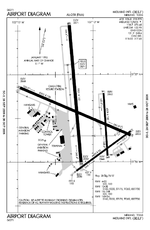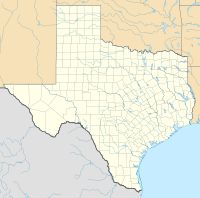- Midland International Airport
-
Midland/Odessa International Airport 
IATA: MAF – ICAO: KMAF – FAA LID: MAF Summary Airport type Public Operator City of Midland Location Midland County, between Midland and Odessa, Texas, USA Elevation AMSL 2,871 ft / 875 m Coordinates 31°56′33″N 102°12′07″W / 31.9425°N 102.20194°W Website Runways Direction Length Surface ft m 4/22 4,605 1,404 Asphalt 10/28 8,302 2,530 Asphalt 16L/34R 4,339 1,323 Asphalt 16R/34L 9,501 2,896 Asphalt Statistics (2007) Aircraft operations 86,384 Based aircraft 78 Sources: airport website[1] and FAA[2] Midland International Airport (IATA: MAF, ICAO: KMAF, FAA LID: MAF) is a city-owned public-use airport located eight nautical miles (15 km) southwest of the central business district of Midland, a city in Midland County, Texas, United States.[2] The airport is also northeast of central Odessa.
Midland International Airport is the 9th busiest airport in Texas. Since 1991 it has been the headquarters of the Commemorative Air Force (CAF) and the American Airpower Heritage Museum. The CAF hosts an annual airshow every fall. The airport has four airlines, three of which serve hubs with regional jets, and one that offers mainline jet service to various destinations. Southwest Airlines is the largest carrier at the airport. In 2007 491,834 passengers were enplaned, up 4% from 2006.
Contents
History
Midland-Odessa Regional Airport (MAF) opened its new passenger terminal in the early 1960s. At the time, MAF was served by Continental and Trans-Texas, both of whom operated popular point-to-point services linking West Texas towns.
The terminal was identified by its scalloped roofline, which allowed a column-free interior. All services - ticketing, baggage claim and concessions, were located inside the building, and a single departure lounge opened up onto the apron. Continental and Trans-Texas both introduced DC9 jet flights in the late 1960s.
This layout served the airport well until the late 1970s 'oil boom' hit Midland-Odessa. Rapid economic growth in the two cities led to a dramatic increase in flights, by both the incumbent airlines and new-entrant carriers like Southwest Airlines. After airline deregulation in 1978, American and Delta began flights, followed by start-up America West a few years later.
To cope with the rising demand, a new gate area was constructed along the apron. Included in the plan were four second-level gates equipped with jetbridges, concession space, and escalator wells linking the addition to the existing terminal. The south end of the main terminal was extended to include more ticketing space, and the original terminal was modernized (the scalloped roofline was removed).
By the 1990s, several of the new-entrant carriers had pulled out and most of the remaining airlines had downgraded to regional jets. Only Southwest, the airport's largest carrier, operated mainline jet flights.
The terminal building, however, had begun to look tired, and airport officials began planning for a more modern replacement. Construction began on the facility (which would be located in the infield parking lot) in 1996. The first half of the new terminal was opened in early 1999, at which point the 1966 terminal was closed and demolished. The second half of the new terminal was finished in late 1999.
Until the September 11th attacks, everyone was allowed access to the second floor; since then, however, only passengers are allowed past the security checkpoints.
In 2008, Southwest Airlines dropped all direct flight to El Paso, due to decreased passenger counts to that city. An afternoon flight to Austin has also been dropped even though negotiations are underway to keep that flight.[citation needed]
Facilities and aircraft
Midland International Airport covers an area of 1,600 acres (650 ha) at an elevation of 2,871 feet (875 m) above mean sea level. It has four runways:[2]
- Runway 4/22 measuring: 4,605 x 75 ft (1,404 x 23 m), Surface: Asphalt
- Runway 10/28: 8,302 x 150 ft (2,530 x 46 m), Surface: Asphalt
- Runway 16L/34R: 4,339 x 100 ft (1,323 x 30 m), Surface: Asphalt
- Runway 16R/34L: 9,501 x 150 ft (2,896 x 46 m), Surface: Asphalt
For the 12-month period ending February 29, 2008, the airport had 86,384 aircraft operations, an average of 237 per day: 39% military, 34% general aviation, 16% air taxi and 11% scheduled commercial. At that time there were 78 aircraft based at this airport: 39% single-engine, 47% multi-engine , 12% jet and 2% helicopter.[2]
Airlines and destinations
Airlines Destinations American Eagle Dallas/Fort Worth Continental Connection operated by Colgan Air Houston-Intercontinental Continental Express operated by ExpressJet Airlines Houston-Intercontinental Southwest Airlines Albuquerque, Dallas-Love, Houston-Hobby, Las Vegas United Express operated by SkyWest Airlines Denver Top Destinations
Top ten busiest domestic routes out of MAF
(June 2010 - May 2011) [3]Rank City Passengers Carriers 1  Dallas-Love, TX
Dallas-Love, TX143,000 Southwest 2  Houston-Intercontinental, TX
Houston-Intercontinental, TX80,000 Continental, United 3  Dallas-Fort Worth, TX
Dallas-Fort Worth, TX74,000 American 4  Houston-Hobby, TX
Houston-Hobby, TX67,000 Southwest 5  Las Vegas, NV
Las Vegas, NV31,000 Southwest 6  Denver, CO
Denver, CO27,000 United 7  Albuquerque, NM
Albuquerque, NM24,000 Southwest 8  Austin, TX
Austin, TX4,000 - 9  Los Angeles, CA
Los Angeles, CA3,000 - 10  Oakland, CA
Oakland, CA1,000 - See also
References
 This article incorporates public domain material from websites or documents of the Air Force Historical Research Agency.
This article incorporates public domain material from websites or documents of the Air Force Historical Research Agency.- Shaw, Frederick J. (2004), Locating Air Force Base Sites History’s Legacy, Air Force History and Museums Program, United States Air Force, Washington DC, 2004.
- Manning, Thomas A. (2005), History of Air Education and Training Command, 1942–2002. Office of History and Research, Headquarters, AETC, Randolph AFB, Texas ASIN: B000NYX3PC
External links
- FAA Airport Diagram (PDF), effective 20 October 2011
- FAA Terminal Procedures for MAF, effective 20 October 2011
- Resources for this airport:
- AirNav airport information for KMAF
- ASN accident history for MAF
- FlightAware airport information and live flight tracker
- NOAA/NWS latest weather observations
- SkyVector aeronautical chart for KMAF
- FAA current MAF delay information
Categories:- 1941 establishments in the United States
- Buildings and structures in Midland County, Texas
- Airports in Texas
- Airfields of the United States Army Air Forces in Texas
- USAAF Gulf Coast Training Center
- USAAF Bombardiers School
- Transportation in Midland County, Texas
Wikimedia Foundation. 2010.



